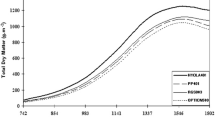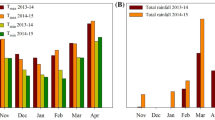Abstract
Present study was undertaken with three categories of seed size of Kabuli chickpea genotypes. Leaf characteristics, viz., number of leaves, leaf area, leaf area index, and specific leaf weight were high in large-seeded category genotypes than other two seed size category genotypes during reproductive phase of plant growth and development. Photosynthetic rate, biomass accumulation was also higher in large-seeded category. Phenological parameters such as days to flower initiation and days to pod initiation were earlier in large-seeded category genotypes, while pods maturity was late in large-seeded category than in medium-and small-seeded category. However, mean number of flowers plant−1 was higher in medium-seeded category than in small-and large-seeded categories. Yield contributing parameters at harvest viz., per cent filled pods, number of seeds plant−1, number of pods plant−1, 100-seed weight, partitioning coefficient, harvest index and yield were greatly affected by seed sizes. On the basis of varietal differences, small-seeded genotypes GLK 26155 and BG 1053, and medium-seeded genotypes GLK 26164 and GLK 25121 had higher biomass, per cent filled pods, number of pods plant−1, Per cent pod set, 100-seed weight, partitioning coefficient and yield plant−1, while in large-seeded category, genotypes GLK 28119 and GLK 28126 showed higher biomass, per cent filled pods, per cent pod set, 100-seed weight, partitioning coefficient, harvest index and yield plant−1. Large-seeded genotypes showed higher Per cent filled pods, 100-seed weight, Per cent pod set and partitioning coefficient, followed by medium-and small-seeded genotypes, but the differences were non-significant.


Similar content being viewed by others
References
Basu, P. S., & Singh, D. N. (2003). Physiology and abiotic stresses in chickpea. In M. Ali, S. Kumar, & N. B. Singh (eds) Chickpea research in India (pp. 137–166). Kanpur, India: IIPR.
Bhor, S. B., Thete, R. Y., Patil, R. B., & Bharud, R. W. (1988). Effect of seed size on growth, yield, yield attributes and seed quality of gram. Seed Res, 16, 143–147.
Chitti Babu, G. (1992). Performance of groundnut different levels of pod grading, plant population and seed invigorations. M.Sc. thesis, ANGR Agricultural University, Hyderabad.
Cochran, W. G., & Cox, G. M. (1967). Experimental designs. New York: Willey.
Dahiya, B. S., Solanki, I. S., & Kumar, R. (1985). Germination rate and its genetics in Chickpea. International Chickpea Newsletter, 13, 6–8.
Dantuma, G., Von Kittlitz, E., Frauen, M., & Bond, D. A. (1983). Yield, yield stability and measurements of morphological and phenological charatcers of faba bean (Vicia faba L.) grown in a wide range of environments in Western Europe. Zeischrift fur Pfanzenzuchtung, 90, 85–105.
Economic Survey of India (2008–2009). Ministry of Finance-Govt. of India (pp. 17–20).
Egli, D. B. (1999). Variation in leaf starch and sink limitations during seed filling in Soybean. Crop Science, 39, 1361–1368.
Egli, D. B., & Bruening, W. P. (2003). Increasing sink size does not increase photosynthesis during seed filling in soybean. European Journal of Agronomy, 19, 289–298.
ESHA Food Data Base (2010). In The world’s healthiest foods. Salem, Oregon, USA: ESHA Foundation. http://www.whfoods.org.
FAO (2010). Food and Agriculture Organization of the United Nations (FAO) Statistical databases. http://www.fao.org.
Gil, J., Nadal, S., Luna, D., Moreno, M. T., & de Haro, A. (1996). Variability of some physico-chemical characters in Desi and Kabuli chickpea types. Journal of the Science of Food and Agriculture, 71, 179–184.
Hiscox, J. D., & Israelstam, G. F. (1979). A method for extraction of chlorophyll from tissues without maceration. Canadian Journal of Botany, 51, 1332–1334.
Hussaini, S. H., Sarada, P., & Reddy, B. M. (1984). Effect of seed size on germination and vigour in maize. Seed Research, 12, 98–101.
Ibrikci, H., Knewtson, S., & Grusak, M. A. (2003). Chickpea leaves as a vegetable green for humans: Evaluation of mineral composition. Journal of the Science of Food and Agriculture, 83, 945–950.
Kirk, J. T. O., & Allen, R. L. (1965). Dependence of chloroplast pigment synthesis on protein synthesis: Effect of actidione. Biochemical and Biophysical Research Communications, 21, 523–530.
Lima, E. R., Santiago, A. S., Araujo, A. P., & Teixeira, M. G. (2005). Effects of the size of sown seed on growth and yield of common bean cultivars of different seed sizes. Brazilian Journal of Plant Physiology, 17, 273–281.
Liu, P., Gan, Y., Warkentin, T., & McDonald, C. (2003). Morphological plasticity of chickpea in a semi-arid environment. Crop Science, 43, 426–429.
Panigrahi, P. K., & Biswal, U. C. (1979). Ageing of chloroplasts. In vitro-Quantitative analysis of the degradation of pigments, proteins and nucleic acids. Plant and Cell Physiology, 20, 775–779.
Planchon, C. (1979). Photosynthesis, transpiration, resistance to CO2 transfer and water efficiency of flag leaf of bread, durum wheat and triticale. Euphytica, 28, 403–408.
Royo, C., Ramdani, A., Moragues, M., & Villegas, D. (2006). Durum wheat under Mediterranean conditions as affected by seed size. Journal of Agronomy and Crop Science, 192, 257–266.
Saxena, N. P., & Shekdrake, A. R. (1976). Pulses physiology annual report 1975–1976. Part II: Chickpea physiology (pp. 176). Hyderabad, India: ICRISAT.
Tiwari, D. K., Tiwari, J. P., & Agrawal, V. K. (1978). Evaluation of soybean for high germinability and field emergence. Seed Research, 6, 125–128.
Upadhyaya, H. D. (2003). Geographical patterns of variation for morphological and agronomic characteristics in the chickpea germplasm collection. Euphytica, 132, 343–352.
Upadhyaya, H., Kumar, S., Gowda, C., & Singh, S. (2006). Two major genes for seed size in chickpea (Cicer arietinum L.). Euphytica, 147, 311–315.
Van der Maesen, L. J. G. (1972). A monograph of the genus with special reference to the chickpea (C. arietinum L.) Veeman and Zoren, Wageningen, The Netherlands.
Weber, H., Borisjuk, L., & Wobus, U. (1996). Controlling seed development and seed size in Vicia faba: A role for seed coat-associated invertases and carbohydrate state. The Plant Journal, 10, 823–834.
Author information
Authors and Affiliations
Corresponding author
Rights and permissions
About this article
Cite this article
Choudhary, S., Kaur, J., Singh, S. et al. Variations in morpho-physiological and yield attributes of kabuli chickpea genotypes in relation to seed size. Ind J Plant Physiol. 19, 28–35 (2014). https://doi.org/10.1007/s40502-014-0065-z
Received:
Accepted:
Published:
Issue Date:
DOI: https://doi.org/10.1007/s40502-014-0065-z




